Author: Jake Huolihan
Out of all of the interesting xBmt results observed over the years, those exploring the impact of mash temperature have been some of the most shocking, at least for me. Despite producing clearly observable differences in FG, tasters have been unable to reliably distinguish beers mashed at disparate temperatures, calling into question claims that mash temperature can be used to adjust body and mouthfeel.
The reason for the FG differences based on mash temperature can be explained by the activity of alpha and beta amylase, the former of which is active at warmer temperatures and produces a less fermentable wort while the latter prefers cooler temperatures and creates a more fermentable wort. The ostensible belief held by many is that warmer mash temperatures lead to sweeter beer with thicker mouthfeel, which makes sense on the surface seeing as more long chain sugars remain.
Admittedly influenced by earlier xBmts on the topic, I’ve all but accepted that mash temperature has minimal impact on the perceptible qualities of beer. However, I continue to regularly witness brewers offering advice to make mash temperature adjustments for the purposes of body and mouthfeel characteristics. Curious to see what I might be missing, and in the spirit of good science, I designed a replication xBmt to test the extremes out for myself!
| METHODS |
For this comparison I whipped up a simple Helles in hopes of any differences being easily recognizable.
Oberteig
Recipe Details
| Batch Size | Boil Time | IBU | SRM | Est. OG | Est. FG | ABV |
|---|---|---|---|---|---|---|
| 5.5 gal | 60 min | 21.4 IBUs | 3.7 SRM | 1.045 | 1.008 | 5.0 % |
| Actuals | 1.045 | 1.008 | 4.9 % | |||
Fermentables
| Name | Amount | % |
|---|---|---|
| Odyssey Pilsner | 9.75 lbs | 89.66 |
| Weyermann Vienna | 1.125 lbs | 10.34 |
Hops
| Name | Amount | Time | Use | Form | Alpha % |
|---|---|---|---|---|---|
| Loral | 5 g | 60 min | Boil | Pellet | 10.3 |
| Loral | 13 g | 30 min | Boil | Pellet | 10.3 |
| Loral | 5 g | 5 min | Boil | Pellet | 10.3 |
Yeast
| Name | Lab | Attenuation | Temperature |
|---|---|---|---|
| Global (L13) | Imperial Yeast | 75% | 46°F - 56°F |
Notes
| Water Profile: Ca 65 | Mg 0 | Na 8 | SO4 67 | Cl 68 |
Download
| Download this recipe's BeerXML file |
I whipped up a large starter of Imperial Yeast L13 Global a couple days ahead of time.
The night before brewing, I collected my water and adjusted it to my desired profile.
The next morning, I turned on the elements to heat my brewing water then proceeded to mill both identical sets of grain, which I’d measured out the night before.
While waiting for the water to reach strike temperature, I weighed out the kettle hop additions.
Since this variable would require dual mashes, I mashed in on the low mash temperature batch 30 minutes before the high mash temperature batch, treating them identically otherwise. Once the grains were fully incorporated into each mash, I checked to ensure I hit my target temperatures.
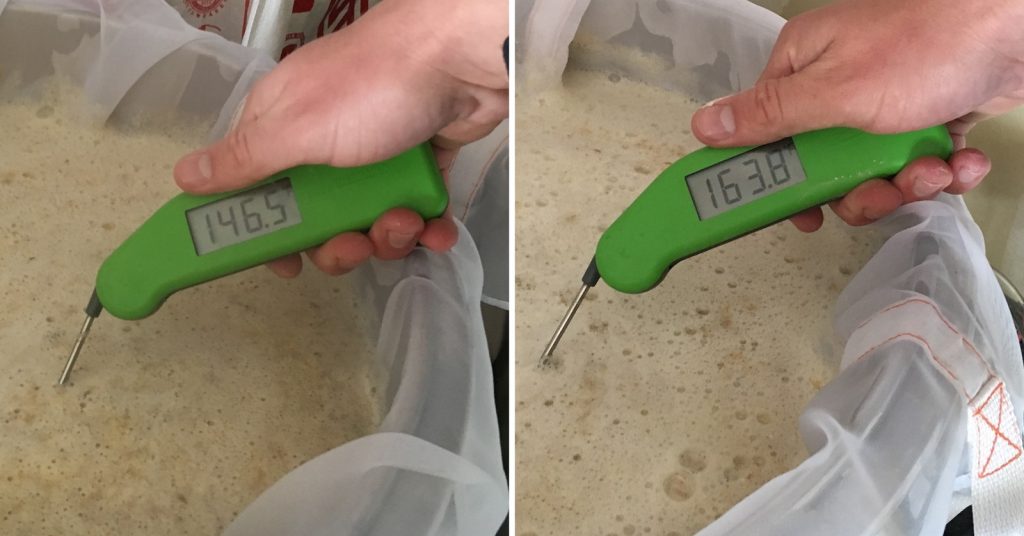
The mashes were left to rest for 60 minutes apiece, each on receiving a gentle stir every 15 minutes.
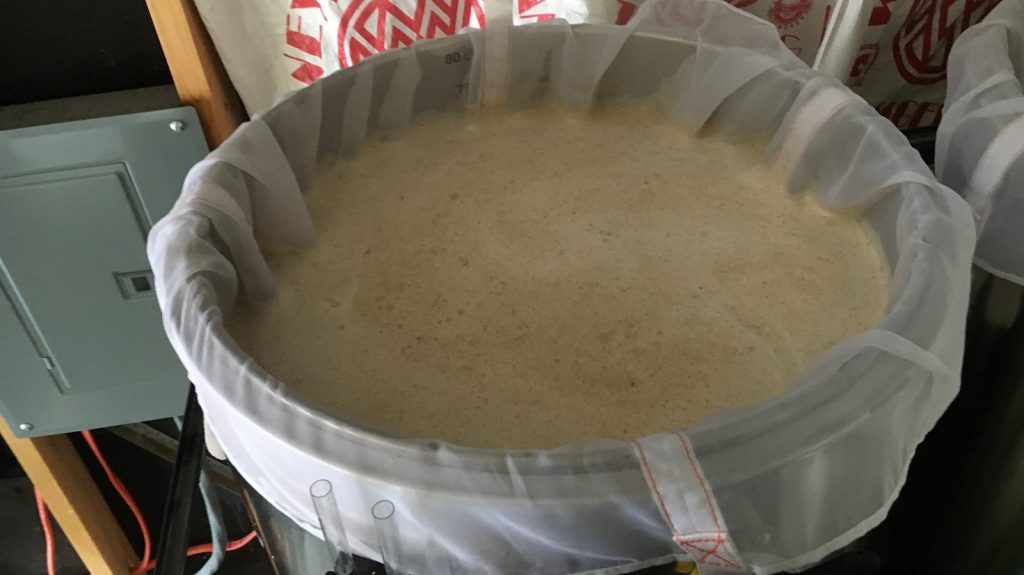
With the mashes complete, I lautered into separate boil kettles.
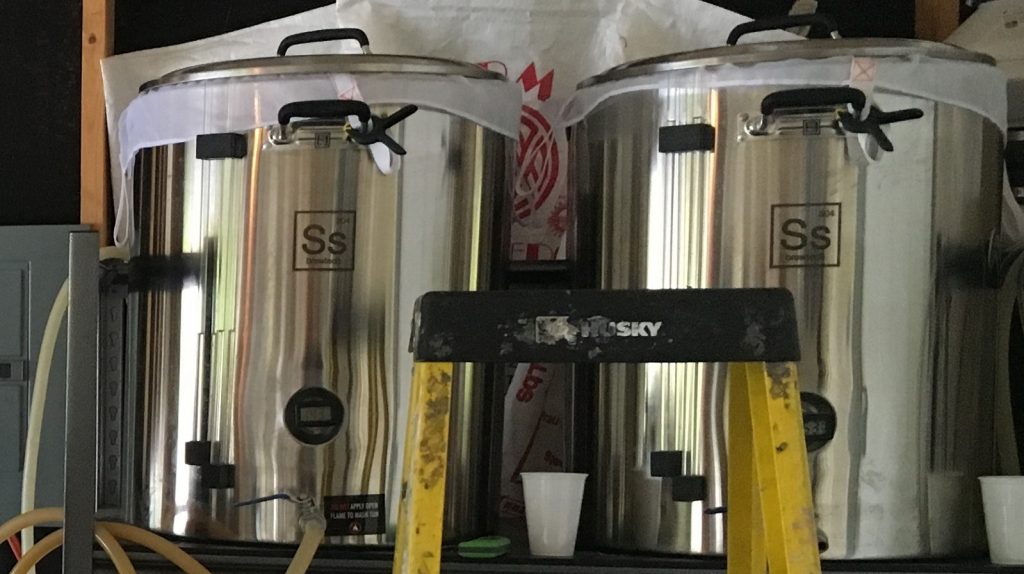
The elements were cranked up to heat the wort and each batch was boiled for 60 minutes with hops added at the times stated in the recipe.
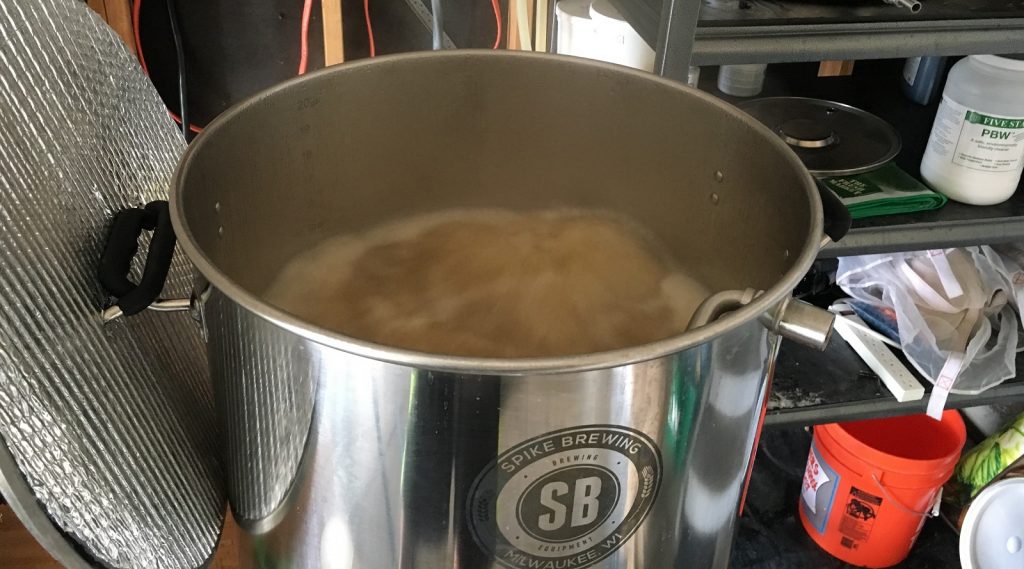
During the boil, I noticed the high mash temperature batch had more foam than the low mash temperature wort. When the boils were finished, I quickly chilled the wort.
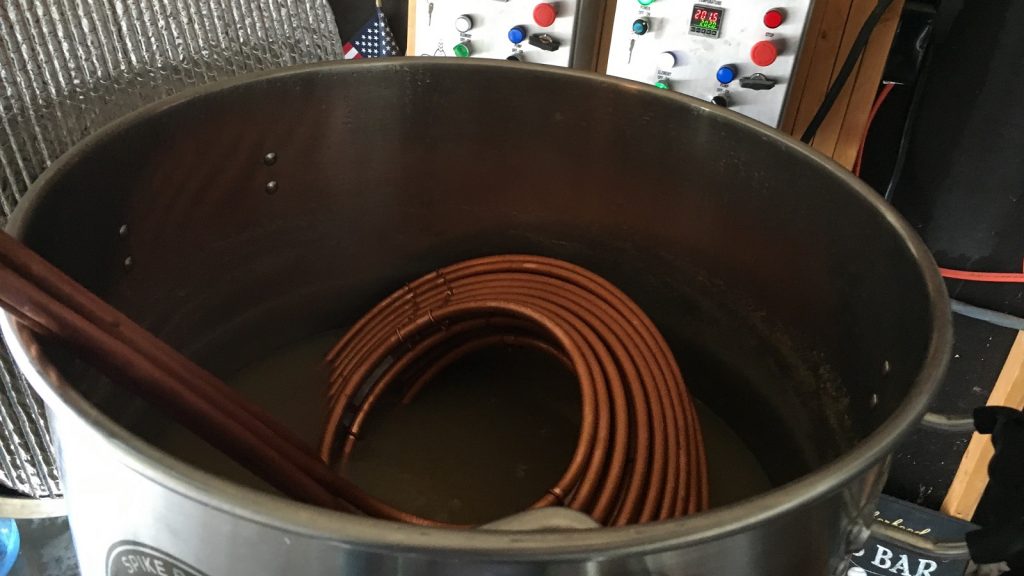
Refractometer readings revealed the low mash temperature wort was at 11.3° P (1.045 OG) while the high mash temperature wort was at 12.1° P (1.049 OG). Interesting…
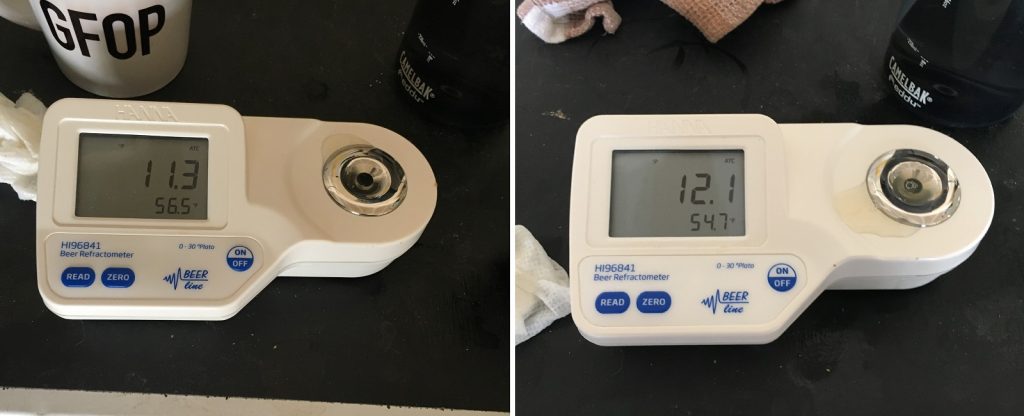
Equal amounts of wort from each batch were racked to separate sanitized Brew Buckets.
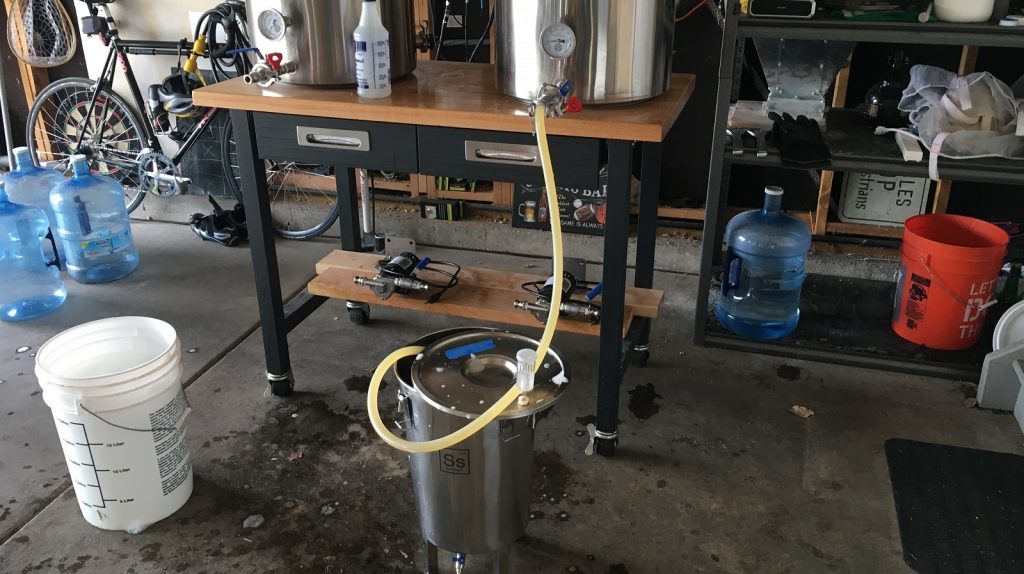
The fermentors were placed next to each other in my fermentation chamber and allowed to finish to 50°F/10°C. Once there, I pitched identical amounts of decanted yeast starter into each batch before giving them 90 second doses of pure oxygen. Both batches were fermenting happily the next morning and were left alone for 14 days before activity had come to a halt. Hydrometer measurements confirmed previous findings that mash temperature has a rather drastic impact on attenuation.
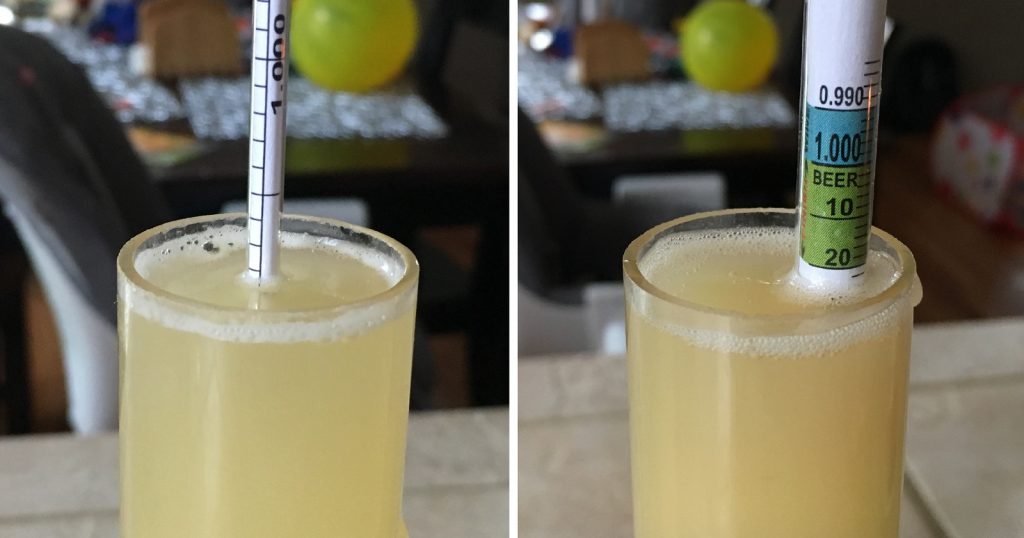
The beers were transferred to CO2 purged kegs then placed in my cool keezer.
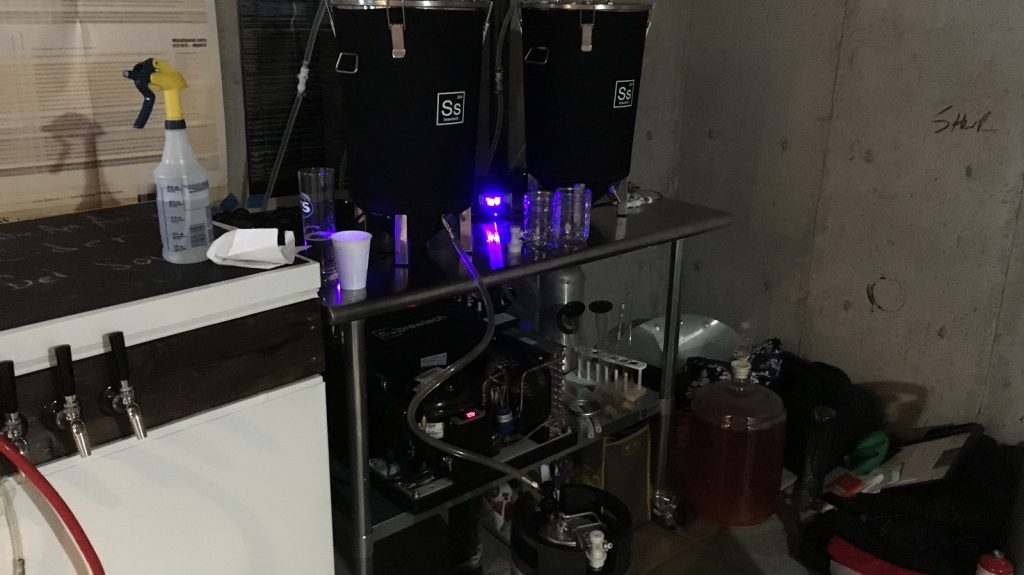
After 8 weeks of lagering on gas, the beers were clear, carbonated, and ready to be served to participants!
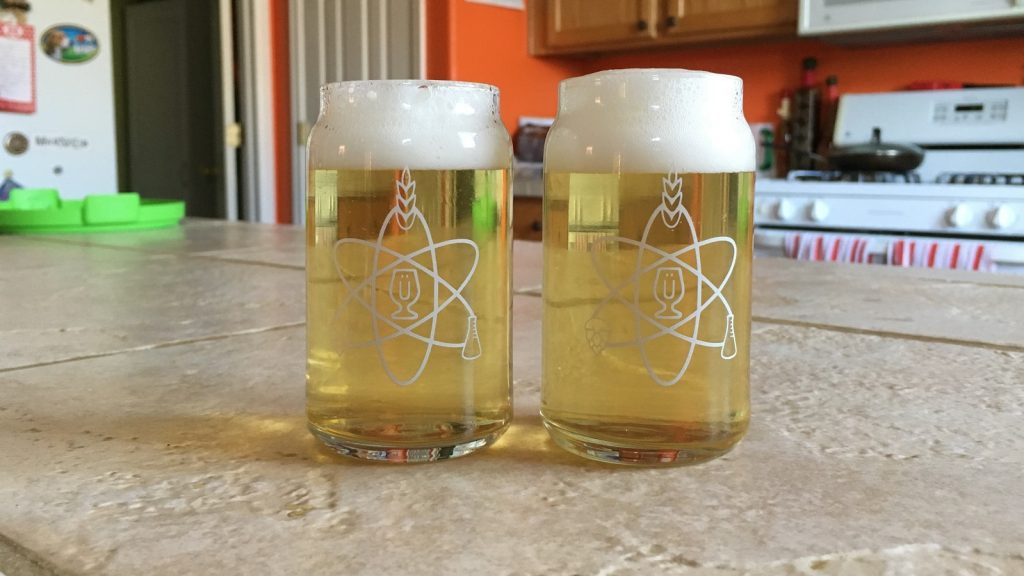
| RESULTS |
A total of 33 people of varying levels of experience participated in this xBmt. Each participant was served 2 samples of the low mash temperature beer and 1 sample of the high mash temperature beer in different colored opaque cups then asked to identify the one that was unique. Given this sample size, 17 tasters (p<0.05) would have had to correctly identify the unique sample in order to reach statistical significance. In the end, only 12 tasters (p=0.42) made the correct selection, indicating participants in this xBmt were unable to reliably distinguish a Helles mashed at 147°F/64°C from one mashed at 164°/73°C.
My Impressions: I attempted 5 semi-blind triangle tests and accurately selected the odd-beer-out 3 times. Not a slam dunk, but I seemed to perceive the high mash temperature beer as having an ever so slightly stronger flavor of Pils malt. Obviously not enough for me to consistently identify it, so it’s possible my bias was at play. Despite their difference in ABV, the beers tasted nearly identical, which was a good thing seeing as I thought they were particularly tasty!
| DISCUSSION |
Mash temperature is viewed by many as a lever one can use to adjust how sweet or dry a beer is, a belief unquestionably informed by the easily observable relationship between mash temperature and attenuation. Who hasn’t received feedback from a judge or fellow brewer to reduce mash temperature because they felt the beer was too sweet? It seems only logical that stark differences in FG would be perceived in such a manner, which is why tasters’ inability to tell apart beers mashed at either 147°F/64°C or 164°/73°C in this xBmt is so shocking– the beers finished 16 SG points apart from each other!
Without question, the beers in this xBmt were different– the cool mash temperature beer was 4.9% ABV while the high mash temperature beer was 3.3% percent. Based on established brewing science, we can assert that the beer mashed warmer contained more long chain sugars thus leading to a lower fermentability. What’s so striking is that neither the differences in alcohol nor sugar content led to perceptible differences in the finished beers.
Interestingly, in De Clerck’s A Textbook Of Brewing Vol. 1, an experiment is discussed that found differences in dextrin level as a function of mash temperature did not produce perceptible differences in mouthfeel or flavor. This along with our xBmt results seems to suggest that mash temperature, with its impact on FG and ABV, may not be as useful of a lever for adjusting beer character as we’ve been led to believe.
As for me and my brewing, I’ll continue to mash most of my beers between 152°F/67°C and 154°F/68°C, as it seems optimal for balancing conversion and yield. I’m really curious about the various methods used to increase the sensation of fullness in beer and look forward to exploring it more in the future.
If you have any thoughts about this xBmt, please do not hesitate to share in the comments section below!
Support Brülosophy In Style!
All designs are available in various colors and sizes on Amazon!
Follow Brülosophy on:
FACEBOOK | TWITTER | INSTAGRAM
If you enjoy this stuff and feel compelled to support Brulosophy.com, please check out the Support page for details on how you can very easily do so. Thanks!


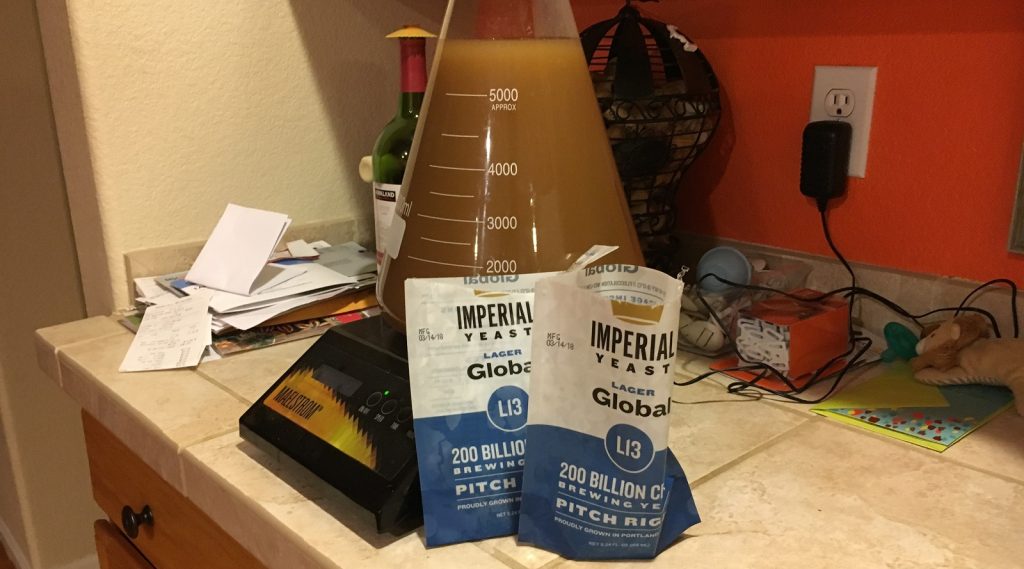
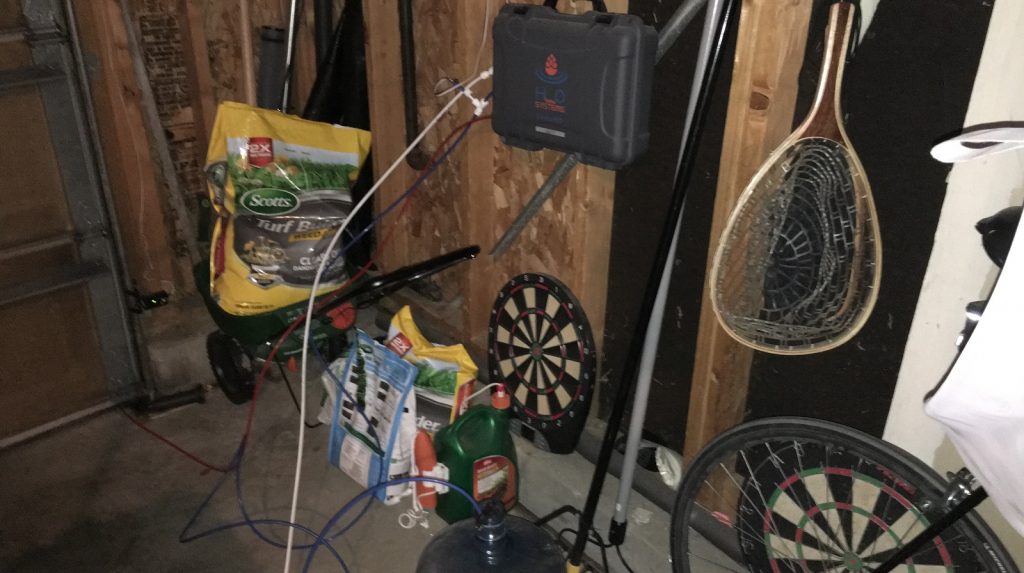

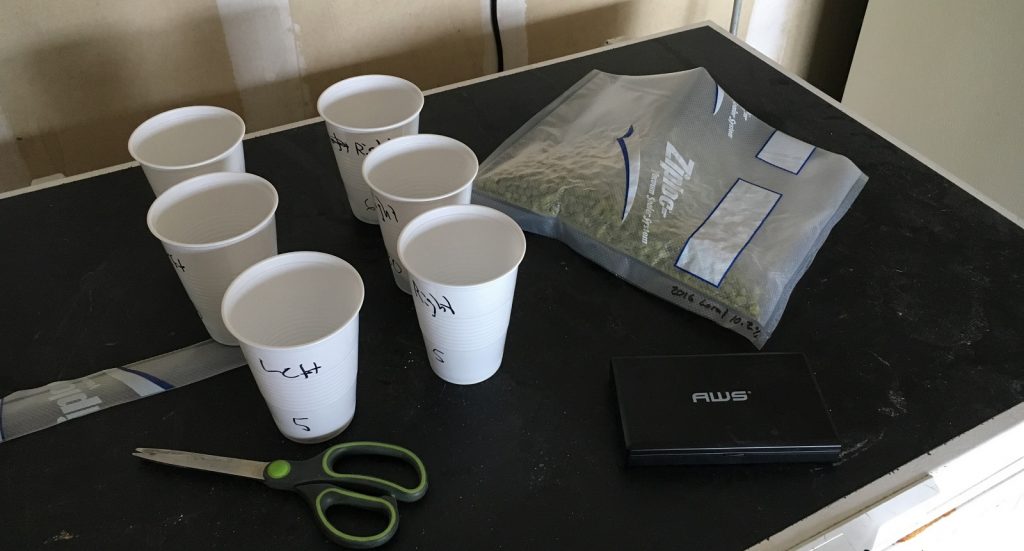








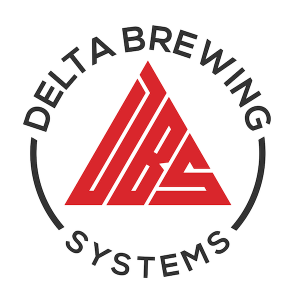


83 thoughts on “exBEERiment | Mash Temperature: Low vs. High In A Munich Helles”
This seems to indicate that increased mash temperature might be an easy method to make a beer that is low in alcohol without making any sacrifices in the department of flavour and mouthfeel. I just wonder if there might be some disadvantages with respect to shelf life and stability. Or digestibility, for that matter…
“the cool mash temperature beer was 3.3% ABV while the high mash temperature beer was 4.9% percent”
The other way around. Right?
Nope
Yep
i think you have mixed up your abv values for the two beers.
Wow crazy unexpected result, Brulosophy smashes another brewing myth! Well done guys, seeing a new xBmt in my inbox makes my day.
The first exbeeriment on this temp difference really got me thinking about this and I’m so happy to see that you guys repeated it! I know this only gives us a sample size of 2 brews but to have this come back non-sig both times despite obvious measurable differences is enough to fascinating!
When were the FG taken? before kegging or after lagering?
Take it to the limit and make a 4% Imperial Stout!
I would be curious to see an Imperial Stout (or Imperial something lighter) to see if the residual sugars do show through at a much higher gravity. Although the same mouthfeel and taste at ~1.045 OG at 52% and 82% apparent attenuation, I wonder if a 1.100 beer going down to 1.046 (52% AA, 7.3% ABV) and 1.017 (82% AA, 11.2% ABV) would be more notable. This also assumes that high gravity yeast would have the same span in apparent attenuation. If nothing else, the alcohol level would be notable.
I made an American stout which finished a good deal higher than expected–maybe about 60% Apparent. I really didn’t care for it. Not sure if it was due to mash pH or not enough enzymes in the mash. I don’t think it was temperature.
A really interesting challenge wijle be to compare the two methods with a temperaturen steps mash. E.g. 50 degrees. 15 min ter. 63 degrees 30 minutes. 73 rente er 15 minuten. 78 degrees sparge. Want would be the conferences bij?
Thanks for the experiment Jake!
Even when reversing the ABV, I do not get the same values. I get 2.9 and 4.6.
I interpret the results differently. Given the large difference in ABV and FG, I would be obliged to consider, among other options, that my instrument (testers) was not good enough. It is a common bias to avoid considering/ discussing this common source of type Ii errors, because in this case it means “insulting” the tasters.
All brewery panels I know are selected and trained (calibrated instrument).
I completely understand that this is impractical in this case, but it is a still an experimental limitation that has to be discussed.
Cheers!
Interesting point, although the fact that untrained beer enthusiasts couldn’t tell the difference is potentially interesting alone!
Certainly is, since many home brewers, the huge majority I suggest, likely fall into those unfortunate not to have “superior”, should I say trained, taste buds. And what if someone does have a more acute sense of taste? Does it make their judgement better, other than simply being able to sense a difference? Would they be able to say why it’s different? I suggest they may not, other than there being a difference. As in all things, beauty is in the eye of the beholder. In this case, the taster. It is not lost on me that, even when tasters can tell the difference in two seemingly indentical beers made during such experiments, that there are invariably those who like one beer, and others choose the second. The beauty of home brewing is that every beer is going to be a little different. That some prefer lagers, pales, IPAs, reds, ambers and stouts. I think the brulosophy experiments are awesome, and rather debunk a lot of unnecessary crap we are told the home brew. It dawns on me that many who often proclaim such intricacies, are those deeply $invested in brewing gear. Much of it is plain hogwash, and home brewing is quite forgiving.
Not sure if I agree. Of course the two beers *are* different. There are clear objective measurements confirming that. We don’t need tasters of any qualification to tell us that. The question, as with all xbmts, is whether this difference is actually perceivable. Many xbmts that fail to achieve statistical significance still have a ‘suspiciously high’ proportion of tasters that get it right, so it seems plausible to assume that there is a (perceivable) difference, but it is ever so slight that most people don’t pick up on it when comparing them side by side.
After all, the question is “does this *really* affect your beer as dramatically as conventional homebrew-wisdom predicts?”
Basically: It might very well be that a panel of trained testers could reliably distinguish the beers. But that is not what the average homebrewer should be overly concerned with, if he is brewing for average beerdrinkers, beer enthusiasts, fellow homebrewers and the occasional BJCP judges – which are the main constituents of the tasting panels in the xbmts here.
I brew for me, and (occasionally if they are lucky) friends. If I’m happy with how it tastes, I don’t care at all what a trained expert thinks.
Either you follow acceptable scientific methods or you don’t. In Sensory Evaluation Techniques (the most common source) there is a clear description of how to control for the test room, the product tested, the panel; what are the factors influencing sensory veredicts, and even the limitations of a triangle test.
I understand that meeting standards carry a cost, and it would make the testing of this experiments impossible; however, one still needs to acknowledge that not following standard methods is a limitation of the experiment that could explain the results. I was just stating one of the many limitations; see the book for a complete list.
In summary, you may agree or not agree, but your disagreement is not with me, it is with the scientists that developed the conditions under which to carry a triangle test.
Best wishes,
Unfortunately advocating for more rigorous scientific methodology seems to be perceived as negativity. While I can only speak for myself, I value the time and effort committed to brewing a 5 gallon batch, never mind 2 batches in parallel, arranging a test panel, tabulating the results and writing it all up. Given the investment in all of that, my hope would be that comments on methodology would be to give greater power and validity to the results with relatively minor changes in the approach.
You are twisting my words and my message a bit. I am not advocating for anything because I know it is cost-prohibitive. Yes, I am stating that the triangle test is not conducted according to standard scientific methodology, but I am not stating it so the tests are done according to standard methods.
I am stating it so that it is acknowledged that because standard methods are not followed, the potential for random variability (ie, statistical noise/ type 2 error) is much higher.
What I wish to prevent is that homebrewers interpret this results to mean that mash temperature does not make much of a difference, and brew in consequence.
Sorry if you think I’m twisting your words and message. My message is that the experiments could be significantly enhanced by qualifying the tasting panel through a relatively simple screening process of having them taste a beer and the same beer with a modification – a small, just detectable, addition of DME, LME, malt vinegar, spice etc to separate the non-tasters from the super-tasters and average tasters. (see my other comment and Scientific American link) This would not be terribly expensive or a huge additional effort. When you realize 25 % of the population are “non-tasters”, consider the effect on the data of all the completed exBeeriments of removing the 25% of each panel who would be “non-tasters” who would weight the results consistently to no difference. Including “non-tasters” in the exBeeriments automatically adds 25% chance that the panelists choice is random and makes the detection of differences less likely. I am not suggesting that only BJCP Judges be required, only that some screen be applied to the judges to ensure they have an average or better ability to discriminate flavour.
Thanks for raising this issue. While I love reading these write-ups and appreciate the work that goes into these exBeeriments, I am always wary of the results and interpretation. As you say, the tasting panel is not screened in any way and there is a wide variation in people’s ability to differentiate taste. Part of that is ability and part of that is training. I know that I for one would make a poor panelist because I have chronic allergies and while I can tell good beer & wine from bad, I would not be able to pic out nuanced differences as I know others can. I have had a fair bit of exposure to tasting of fine wines and even with coaching know that I will reach the limits of my ability sooner than others. Even those with more precise ability and training will be affected by extrinsic factors such as having colds, allergy flares, medications etc so that their ability on one occasion may not be the same on another. Without going as far as having trained tasters for each exBeeriment, it would be quite feasible to have a screen for each exBeeriment’s panel on the day of the trial with triangle tests of a contrived test sample. One might add a fixed amount of DME, malt vinegar, a spice etc to a beer to determine if the tasters were able to detect the difference from the base beer. The addition should be targeted to be related in some way to the exBeeriment itself – ie in this one, adding DME would mimic unconverted sugar, in a hop exBeeriment Malt Vinegar might mimic bitterness, etc. I would think that a screen that eliminated 1/3 to 1/2 of the potential panel (by adjusting the quantity of the addition so that about 1/2 – 2/3 could identify the different beer) would provide a much more discerning panel and improve the quality of the results.
I also note that while all the write ups mention reaching statistical significance or not, the small sample sizes limit the power of the exBeeriments. Not being a statistician, I will simplify the explanation of that comment by saying that it is much more powerful to say that 600/1000 could differentiate something than 6/10. Although in both cases 60% can differentiate the items, 6/10 is much more likely to to be affected by a random error. If a commercial brewer were going to change their formulation, they would likely use prequalified tasters and no doubt use a much larger sample size to test the product change.
I think if you asked any home brewer about mashing 20 deg different they would tell you that is not a nuanced difference in taste or mouthfeel in the finished glass. They tend to test extremes that most home brewers wouldn’t go to so if the average beer drinker can’t reliably tell the difference with that big of a margin that’s good enough for me. It’s far more useful to me than knowing that some super taster can tell the difference but 90% of people can’t. To each their own though, cheers!
I think that it is well proven in food science that “trained tasters” are generally no better than the general population at discerning differences (except for the rare super-taster). The only difference in training is the ability to verbalize the detected differences. I recall another exbeeriment that data mined the results to show that the subset of BJCP judges did no better than anyone else.
As far a sample sizes go you are partially correct – but that is where statistical confidence comes in. Here they look for 95% confidence, which is considered pretty high. But yes, that leaves a 5% chance that the result was due to chance. Bad scientists will drop their confidence levels to manipulate the data to give them the answer they want….
Well, actually taste sensitivity is quite variable – see
https://www.scientificamerican.com/article/super-tasting-science-find-out-if-youre-a-supertaster/
If roughly 25 % are supertasters, 50 % are average tasters, 25 % non-tasters (it seems taste sensitivity would fit a bell curve), then eliminating the non-tasters, favouring super-tasters and including only average tasters who had demonstrated their ability to differentiate would be the best way of assuring that any difference was detected. And if your going to say well average is good enough for me, why would you be asking the question or doing the exBeeriment in the first place ?
You are spot on here. This can be applied to every experiment reported thus far.
wouldn’t the likelihood of type two error depend on what the hypothesis being tested is? If the null hypothesis is that there is no perceivable difference at all, then it is most likely a type two error, if the hypothesis is that an untrained or ‘average’ beer drinker can’t tell the difference then it is less likely and dependent on how representative the sample is of target drinkers?
I’d imagine a professional brewery would have different purposes, different hypothesis and therefore different experiment design needs?
Wow another stunner, huh?! All of our concerns about holding mash temps- boom, not so critical. Besides surprising, these type of findings should make for more relaxed home brewers. Oh those newbies to come have it so easy now with your work! Great job.
I’ve been using Imperial yeast too with it’s 200B counts and especially with low OG beers I’m not concerned with starters (thanks really again to you guys!), curious why you still build them? Keeping to “best practice”?
Cheers and thanks as always for the great work
I thought it was fairly well accepted now that sweetness derived from high(er) FG typically results from incomplete fermentation, as the longer chain dextrins are NOT perceived as sweet.
That doesn’t say anything about the difference in body perception for these beers though!
If mash temperature isn’t affecting mouthfeel like people expected, what can we still do to affect mouthfeel?
Mash hotter but also use a higher OG (keeping the ABV of the recipe sort of the same.)
In my experience if you add a lot of high protein grains like oats the effect on mouthfeel is more noticeable than with mash temperature.
When did you take the FG readings? before kegging or after lagering?
They lagered under CO2 so they definitely took the FG before kegging.
I was just thinking, the beer could have still fermented during the lagering phase and hence attenuate, which could explain the beers were perceived as alike. I normaly meassure the FG after lagering (of course I de-CO2 the beer first)
“Despite their difference in ABV, the beers tasted nearly identical, which was a good thing seeing as I thought they were particularly tasty!”
I’m interested to know if you can have several pints of the one with the higher fg. I don’t think I would be able to perceive much difference in attenuation from drinking 3 small cups. But I think the difference becomes apparent when it comes to drinking further pints even with the higher abv.
I can’t believe that you don’t notice any difference between two beers with DF 1008 vs 1023, really??
Sorry, but I think that unless your palate don’t distinguish a saison from a imperial stout, it’s unbelievable…
Cheers!
Maybe you could do the same experiment then
Very interesting result. If the beers taste very similar but have radically different abv’s, this is surely a great way to make low-alcohol session beers without sacrificing taste or mouthfeel – just mash super high. This is now top of my list of new brews to try.
i’ve been doing just that for several months now, ever since i saw the original exbeeriment. it works great for making lower abv beers with full flavor.
Perfect exbeeriment to help me relax over a recent brew! I brewed a Helles two weeks ago using the LoDo methold with mash cap, but since I don’t have recirculation, I erred in my mash temps during a step mash. I mashed at 147F, capped the mash and walked away, only to come back 20 minutes later to see my temp gauge reading 162F! Obviously the wort at bottom of the kettle was hotter than wort at the top and I did not stir enough. Anyway, I skipped the rest of the step mash steps and just pulled the bag after 60 minutes. My OG finished at 1.047 instead of 1.049 and FG at 1.011 instead of 1.006, so definitely a different beer then it should be. However a sample pulled yesterday and besides being crystal clear, it had great malt flavors and still had a soft dry finish.
Great exbeeriment! I started to mash all my beer at 70C (158F) or warmer after reading the first mash temperature experiment, and I am glad to see this one replicated. I also shorten the mash to 20 minutes, to further reduce the attenuation and get even lower ABV.
It would be interesting to see this replicated in a heavier beer like a barley wine or imperial stout; can subjects tell the difference between a barley wine at 12% ABV and 8% ABV?
Could the low attenuation with high mash temperature be affected by the yeast? E.g. the recipee for one particular traditional Norwegian farmouse ale (Hornindalsøl) is to mash at 74C (165 F) to an OG of 1.075 and still ferment out to FG 1.018 (76% a. attenuation) using Hornindals kveik – a yeast strain handed down from brewer to brewer thorugh generations. (1000 years ago, brewing beer was required by law in Norway.) The particular kveik used for that beer contains bacterias as well as yeast, and the bacterias contribute a caramel note to the beer. The bacterias may explain the high attenuation in spite of high mash temperature. Still, can the low attenuation with high mash temperature depend on the yeast strain?
If you use a yeast with the STA1 (diastaticus) gene, you will still see a lower FG than using one that doesn’t have the gene, regardless of mash temp. For example, I think the WY3711 strain still finished a bit higher using a high mash temp, but the difference was much less than if I had used a non-STA1 strain.
In my mind this is what the experiment shows: higher FG made up for the body of lower alcohol. They taste identical but one has lower alcohol.
It would be interesting to see what would happen with two beers of the same alcohol, but one has a higher OG and FG.
This is what I thought after reading the first experiment, body and mouthfeel could be down to the total mass of malt used. Barley wines and Imperial stouts could be heavier because they have twice the grain per batch. Want more body at the same abv, then add more malt and up the mash tempb to keep abv constant(ish).
This is absolutely true from personal experience. I have routinely made fuller tasting version of beers at the same ABV by using 165F infusion mashes with a mashout.
The Sugar Science of this exBeeriment
Simple sugars (carbohydrates) – monosachrides (glucose,fructose,galactose) and disachrides (Sucrose (table sugar), lactose, maltose) are generally perceived as sweet. Some more than others (ie fructose and sucrose). They are single sugar molecules or two sugar molecules linked together. Complex carbohydrates (polysachrides) are longer strings of sugar molecules linked together that are most commonly known as starches and are not perceived as sweet. They are found in flour, potatoes etc used in bread, pasta etc.
The carbohydrates in malt are complex carbohydrates. The mash conversions that occur is when the two different enzymes (alpha and beta amylase) cut the complex carbohydrates into simple carbohydrates. Enzymes are specific and can only cut the complex carbohydrates at specific points. (Imagine a train made of multiple cars, but that had two kinds of hitches requiring two different tools to unhitch the cars. If you only had one tool you would end up with some big pieces and some small ones depending on the original make up of the train.) As the intro states, the alpha is active at the warmer temperature, whereas the beta is more active at the lower temperature. As it happens the mash at the lower temperature produces “a more fermentable wort”. This is because yeast can only ferment simple carbohydrates and the beta amylase breaks more of the complex carbohydrates in the malt into simple carbohydrates. Conversely, the alpha amylase at high temperature breaks some of the complex carbohydrates into simple carbohydrates (fermentable), but leaves a greater portion of the total carbohydrates as longer pieces which remain complex carbohydrates that are not fermentable. (To continue the train analogy, the beta amylase effectively breaks more of the train into 1 and 2 car pieces whereas the alpha leaves longer mini-trains. Yeast can only deal with the 1 and 2 car pieces.)
It would have been interesting to taste the difference both before boiling and after boil before fermentation as the low temperature mash should have more simple carbohydrates and taste sweeter because sweetness comes form simple carbohydrates. The high temperature mash would not have much sweetness from the unconverted complex carbohydrates, which would also remain in the final fermented beer, and would account for the low attenuation (unfermented complex carbohydrates) and the lack of sweetness (complex carbohydrates are not sweet). Based on the attenuation, the low temperature mash produced about 1.5 X’s as much fermentable sugar and in turn about 1.5X’s ABV. Apparently the unfermented complex carbohydrates remaining provided no perceptible difference in the high temperature mash brew.
I’ve read many explanations of Alpha & Beta Amylase activity. This is one of the most straightforward explanations I’ve come across. Great metaphor.
I know you’ve heard this a lot. But, I think what you learn from your experiments is there are a lot of people who don’t have a very sensitive or well refined palates. I’m a BJCP judge and the first thing I learned is I don’t have words for things I taste and sometimes it is very hard to differentiate the things you taste. It’s like asking a guy what shade of green an expensive painting, most don’t have words, but we generally can see different colors. When tasting beer all the colors are mixed together in that taste and most people haven’t worked on breaking all those flavors apart.
I’ve changed the mash temperature in my beer and there is no doubt the 158 degree beer has more body and sweetness than my 148 degree beer. Belgian trappist beers are a great example of this were they use a base malt to create extremely complex flavors based on temperature and time and yeast.
I love your experiments, but using statistical significance on random (probably not) tasters will tell you what the average taster’s sense. Which in reality is measuring the lack of refined palates more than anything else.
My analogy would be to ask 20 1st graders and 13 adults to explain the difference between the executive and the legislative branch of the US govt. and 12 get it right. It doesn’t meet your 95% confidence level. Your conclusion would be that people can’t differentiate between those two branches, so there is no difference perceivably. I would conclude that the participants haven’t leaned enough to tell the difference. Because empirically there is a difference and empirically there is a significant chemical difference (per your measurements) in these two beers.
My point is: I am available to drink your experiments whenever you like! Thanks!
https://en.m.wikipedia.org/wiki/Dunning–Kruger_effect
Read this and found it interesting, but I’m not sure how you are applying it to Smalley’s comment. Are you saying that he doesn’t judge himself accurately or that those who say qualifying the judges doesn’t matter are right because judges will miss-judge their own abilities anyway ? The Dunning-Kruger article would say that subjective self assessment is not accurate when measured against objective data. The tasting will always be a subjective assessment, but, an objective measure of an assessor’s abilities will identify the reliability of an assessor’s subjective skills. Therefore, BJCP judges will have demonstrated their reliable ability to identify specific attributes in blind tastings, objectively demonstrating a level of discernment others have not. In another post I suggested a screening test to identify tasters who could differentiate a contrived difference (ie adding a small amount of DME, Malt Vinegar or a spice) to identify tasters who could recognize that would objectively measure that the panelists could differentiate flavours more reliably than non-qualifiers. Given that the number of judges will always be limited in these exBeeriments, adding a measure of objectivity and reliability of the judges skills is an important way to enhance the power of the results.
Haha great response
He typed out a pretty thoughtful critique and you send him a link the wiki on the DK effect? Pretty lame.
Nah had meant to reply to brewer4you who made a comment about me not being able to differentiate abv. Mobile commenting sucks
Ah, gotcha. Apologies Jake.
You’re absolutely correct that most people have a hard time finding words for things and if asked to describe how it was different might fall short, but that doesn’t mean that the average person can’t notice a difference even if we don’t know how to describe it.
They’ve at least once broke it out between “average” people and BJCP judges for the tasting results and I know at least on one of them the average people performed better (neither were sig).
It’s so easy to want to explain a result that you don’t believe away, but if you’re so sure you could taste the difference brew a side by side batch and have someone set up a triangle for you.
have you done a side-by-side comparison of 148 vs 158? if not, don’t be so sure.
Have you tried switching your hydrometers back and forth between two beers?
And comparing hydrometer-to-refractometer readings? I have noticed significant
differences especially in electronic devices. What about pH? Acidity level could affect
perception of sweetness/sugar (mouthfeel).
Wow, that was a cheap shot. Why don’t you just explain why you disagree with him?
Post was meant to reply to brewer4you my bad
I guess a big question is what was the context of the panelist trial? 30 is a decent number for a difference test, but where was the test done and were the panelists allowed to drink any other beers within 30 minutes to and hour prior to participation? Literature generally shows the discrimination of threshold for ethanol in beer to be between 0.5 – 1.5% abv, so this experiment definitely falls in that range.
Science is built on the shoulders of previous science. The first part of any scientific article is a review of the previous literature. Many smart scientists thought about these problems for years and came up with processes to minimize bias and random error and maximize an effect. They knew what they proposed was not easy but concluded it was needed. We owe to them to read what they had to say and take it into account.
I do like your idea from a lay perspective, but I do not know what would be its relative effect on minimizing error vs. accepted methods so I cannot comment. Developing methods take time and effort.
I would be interested to see this kind of xbrmt repeated with a beer style that uses more dextrin(aka carapils), crystal, and roasted malts. I didn’t search hard but it looked like the other mash temp xbrmt was all base malt as well. Maybe the difference in mouthfeel would be more perceptible if the malts used were knowingly supposed to leave more residual sugars in the finished beer. But then again maybe it wouldn’t matter and people will still say the tasters just suck. I, for one, enjoy reading these because it get me thinking of all the possibilities involve in making beer. Cheers!
I’d be interested to know if size of sample would make the beers more distinguishable. Pretty sure I’d be full after drinking 16 oz 1.023 beer.
i think you are right that the higher mash temp version of the beer would be more caloric. so, you would probably feel more full quicker. however, i don’t think it’s as dramatic as feeling full after one beer. you might only want to drink 3 instead of 4.
Calories depend almost exclusively on OG. A very high FG beer may have 2-4% more calories than a low FG beer, not much.
Anyway I am not sure it is difference in calories. I understand alcohol calories are “empty calories” meaning they are not satiating. Drink 1000 calories of vodka and still be hungry. But the unfermentable sugars left in a high FG beer are probably quite filling. That at least is what BMC marketers have made me think over decades of advertising campaigns including “great taste less filling”.
i just ran the numbers on the brewer’s friend calculator. it is like 5% difference in calories, not much. i don’t feel fuller from the higher FG beers, but you may be different. the lower alcohol i can definitely feel. 🙂
These experiments are awesome and I love the discourse they spark. I’m wondering if it’s worthwhile to do literature research to see if similar experiments have been done and get an expected result that you can compare your results to. You can then tweek the experiment to fill any gaps in the literature. It would also validate your own garage experiments (that is NOT meant to be disparaging at all) if the results agreed with each other. Just a thought. Cheers.
We actually usually do quite a bit of research for each article and xbmt. Often it makes it into the article in a more condensed version so the articles don’t get too long and boring. For this article the studies I found seemed to indicate dextrins present in beer have no perceivable affect in sensory until you reach a delta of 50 g/l of concentration which this specific result failed to reach.
Excellent and interesting experiment. I’m sure I am not the first to mention this, but i think it would awesome if in addition to the panel of testers, some experiments could include a 3 person panel of BJCP judges to engage in the triangle tests. Then we could say well the average beer drinker can’t tell the difference, but 2/3 BJCP judges could, for example. That would provide interesting data points about expert tasters perceptions.
Interesting experiment.
Maybe try again with more specialty/flavorful malts to notice the difference.
I’m wondering if there is a critical threshold of FG where you will tell a difference. I did a Brut IPA recently, and I was surprised that it did not taste “bone” dry at an FG of 1.001. It tastes drier for sure, but not ultra extreme. Maybe 1.030 vs 1.010 is not a big deal but 1.020 vs 1.001 would be more noticeable. hard to say.
Wow! This one hit a nerve…
I’ll say again what I’ve said on other EXBs–what this experiment shows is that, given the number of tasters, people could not reliably perceive (or articulate) that there was a difference. Not that the beers aren’t different…they are. But that this set of tasters couldn’t perceive it. Data are data. And sure, there’s lots of other ways to line up the experiments but I think the whole purpose of the site is to describe what PRACTICAL differences are worth focusing on. Maybe 15 BJCP judges could be able to tell the difference. But your buddies aren’t generally BJCP judges. It goes in the reverse too–if the experiment says the perception of difference is statistically significant, then it just is.
As a former starch chemist (yeah, there’s such a thing) this makes sense because dextrins and other long-chain carbohydrates are neither fermentable nor sweet. I’d guess that if you tested the viscosity of these beers you’d be able to see a difference, but no drinker has one of those and in the end who the hell cares. The perception of mouthfeel is affected by dextrins but also by the proteins in grain. Since these are both well-modified barley products (no wheat/oat/etc) then it’s less surprising that the difference is not detectable.
What WOULD be interesting (but impossible, obviously) is to have these exact tasters have 3 beers from the low mash temp and report back how their…ummmm…body responded to them within the next 24 hours, then have them drink 3 beers from the high mash temp and get the same feedback. I suspect there’d be a difference. From personal experience I only knew that my old mash tun’s temp probe was broken when four beers I made in a row (a) all had much higher terminal gravities than I expected, and (b) all created a much higher “fart quotient” (ha ha, my words) than most of my other beers. Sure enough I bought a ThermaPen and found the tun was reading 11ºF cooler than actual temps so i was often mashing in the low 160s.
IOW the perception of a difference in these beers is not significant in the moment, but might very well be significant when it hits your gut microflora.
YMMV.
“As a former starch chemist (yeah, there’s such a thing) this makes sense because dextrins and other long-chain carbohydrates are neither fermentable nor sweet.”
Right, but you and I both have amylases in our saliva. We can rapidly break dextrins these down in our mouths so much so that a saltine left on the tongue can become very sweet. I wouldn’t be surprised if the tasters here were a heterogenous batch of folks who (because of genetics) produced different levels of AMY1–if you took just the set with the highest amylase levels I would hypothesize that they’d regularly say that the under attenuated beer seemed sweeter.
I’m assuming you built the recipe in BF? Were you surprised by the FG on the beer with the 163F mash? I’m thinking about making a hoppy session beer and mashing around the same temp. I’m wondering if I should add 10 points to my FG in Brewer’s Friend…
Each of us has amylase in our saliva and the amount of amylase can vary WIDELY between individuals.
So I am surprised and a little skeptical that less attenuated beers taste don’t taste sweeter than more attenuated beers. At least I’m skeptical that this is a universal truth.
There are a lot of these experiments that show that the panels can taste the difference, sometimes overwhelmingly. Even if a super judge could have split them, they must be closer than they should be by conventional wisdom. From what I have read and the common beliefs about light beer the judges should have picked the difference before they entered the room. I think as many have suggested that this needs to become a core component of advice to low alcohol brewers, it represents a genuinely effective use of mash temp.
I’d Like to see a xBmt with somethin a bit stronger either in alcohol content or IBU’s like an IPA or an Stout
My main takeaway is that I will continue to not bother measuring my FG unless I have a specific reason to.
I think you can read these results in a different way. If a low mashed, higher ABV, higher attenuated beer is perceived as the same as a higher mashed, lower ABV, less attenuated beer then mash temperature can be a useful lever. They are different in terms of ABV but they taste similar despite being objectively different.
An interesting comparison would be a low mashed beer with same ABV as a high mashed beer.
Also I think sometimes the differences are more noticeable at the extremes. I’ve found that to make tasty low ABV beer (2% or less) you definitely need a high mash, whereas on the other hand you need a low mash on a high gravity Belgian, say >10% ABV to get a clean taste without it being heavy.
All this does nothing to challenge your results, just interpretation and context, keep up the good work.
I mashed for quite a while at 147°F trying to achieve greater fermentability, for financial reasons(I’m a professional brewer). However, I noticed that the head retention of my beers was very short lived(due to a lack of long chain sugars.) So I’ve recently increased the temperature to 152-153°F and although the FG is finishing higher (around 1.012), I’m getting greater extract to compensate as well as longer lasting foam retention.
My personal opinion is that if you want to attain a slightly sweeter style, there is no reason to waste the money on grains to produce more fermentable long-chain alcohols, but instead, just add an measured amount of less fermentable sugar to attain a certain sweeter, and lower fermentable and thus lower alcohol style of beer or ale. It’s really best, imho, to mash at the proper level. If you desire less body, just use less malt, but mashing is best between 150-155 F. I try to stay in the middle, if at all possible, so I get the most for my buck. Grains are expensive these days!